Attending Oktoberfest this year and aren’t quite sure what you’re getting yourself into? This detailed guide shares all my top tips for enjoying your time on the Wiesn!
This post contains affiliate links, from which we may receive a commission. You can read our full affiliate disclosure here.
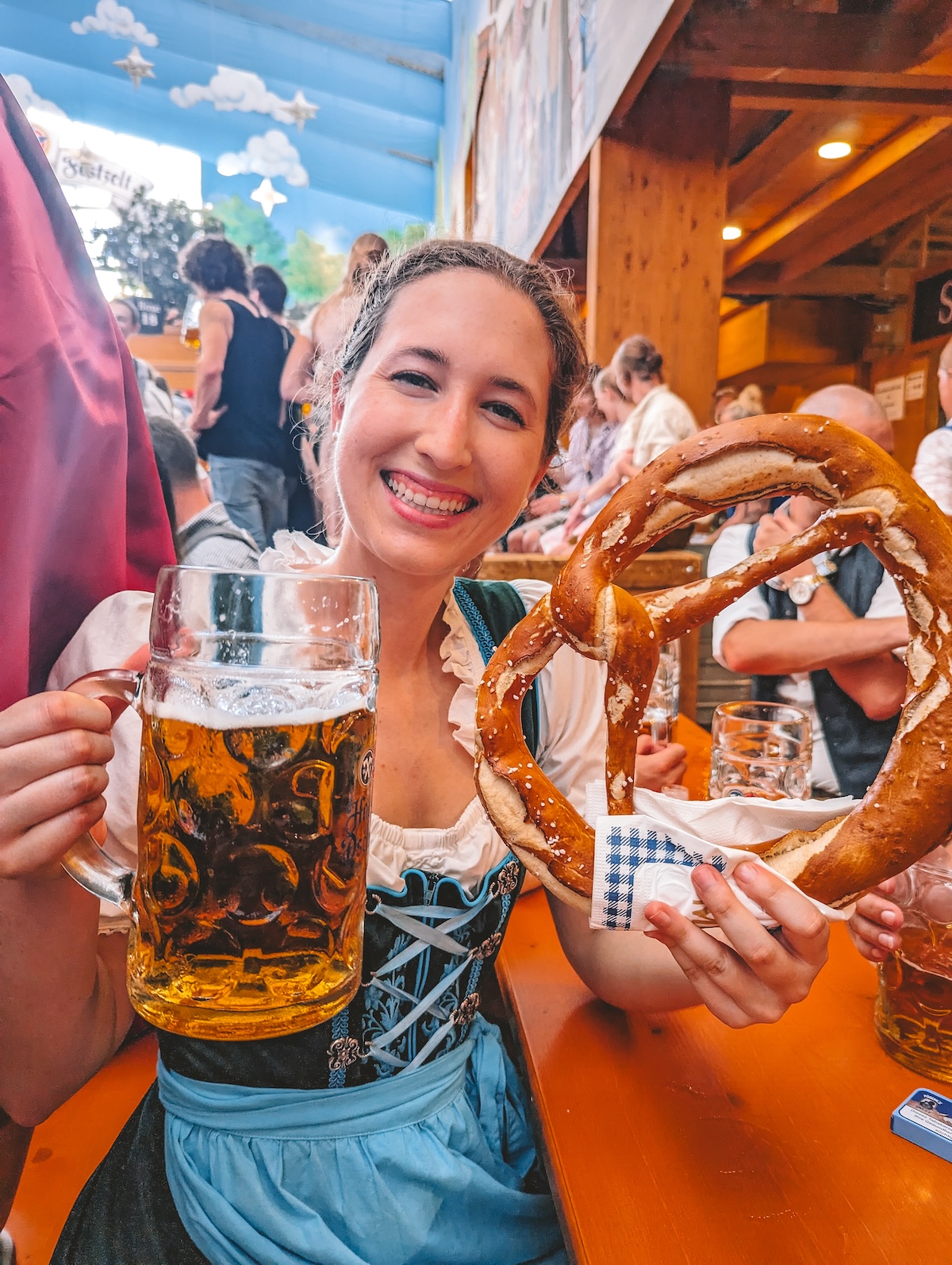
A crowd of onlookers wearing folk dress eagerly count down — drei, zwei, eins! — in time with a rhythmic thumping. A stein full to the brim with foamy beer is finally held aloft.
“O’zapft is!” It is tapped!
The Oktoberfest celebrations can officially begin now that the first barrel of beer has been tapped by the mayor of Munich inside the Schottenhamel tent.
This is how Oktoberfest starts each year, and 2025’s festivities will be no different. This year marks the 190th running of the world’s largest folk festival, and if you’ll be visiting for the first time you’re in for a real treat!
In this post, I’m sharing my ultra detailed guide to Oktoberfest. After five years of living in Germany, I finally made the pilgrimage to Munich to experience the festival for myself and am kicking myself for not going sooner.
If you’re looking for more information on where Oktoberfest is, how to get there, how much a beer costs, and generally what to expect on the Wiesn, keep reading!
Have Fun! Claire
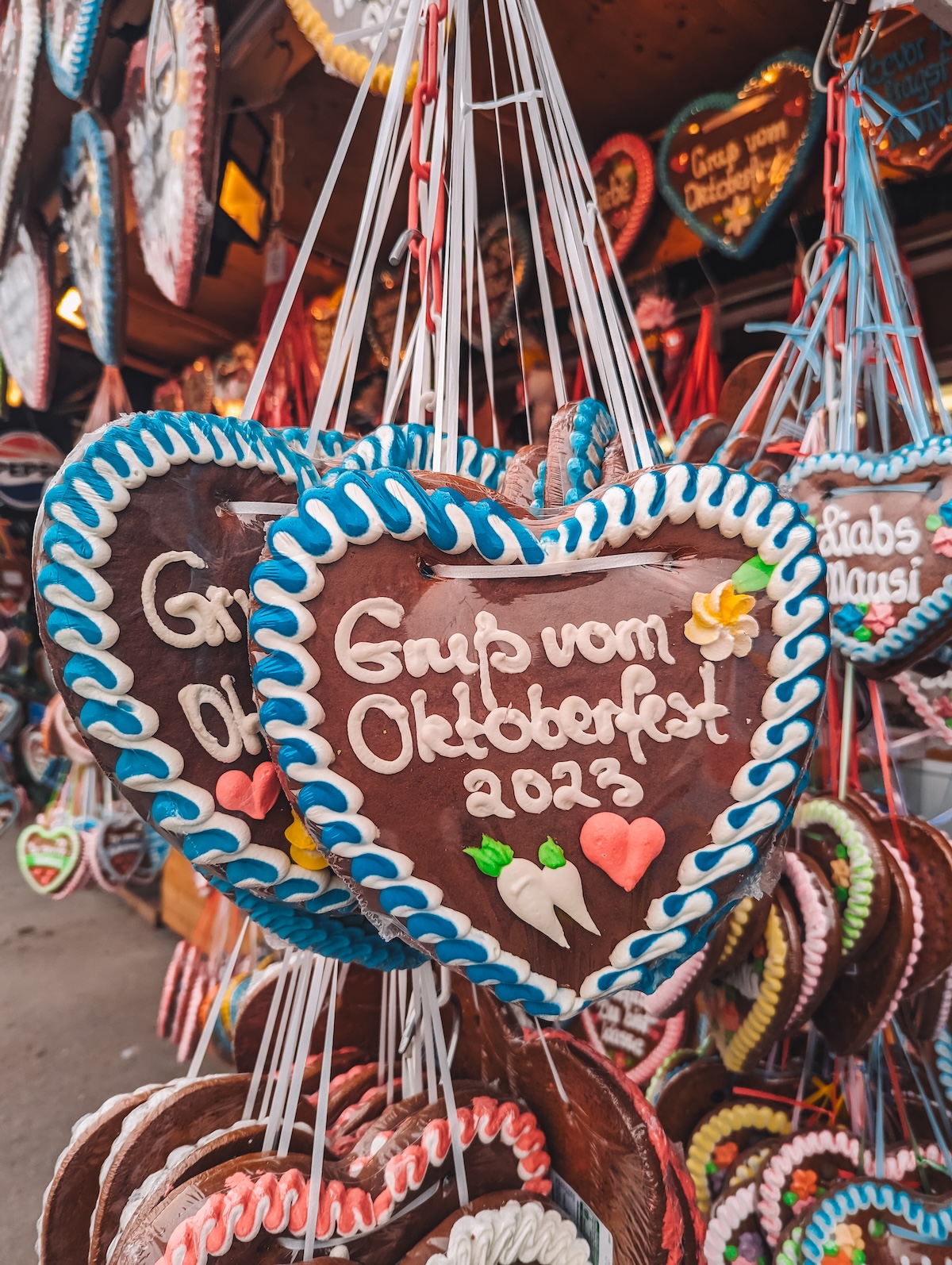
Oktoberfest 2025 Dates, Location & Opening Hours 🍻
Dates: September 20 – October 5, 2025
Location: Theresienwiese in Munich
How to get there: It’s a 15-minute walk to the Wiesen from the central train station, or you can ride the U-Bahn (lines U4 or U5) 1 stop to the station “Theresienwiese.”
Beer service hours: 10am – 10:30pm (tents open at 9am on weekends and on October 3rd)
Stall opening hours: Mo – Th 10am – 11:30pm; Fr 10am – midnight; Sa 9am – midnight; Su 9am – 11:30pm
Tip: Follow the Sidewalk Signs to Reach the Wiesn!
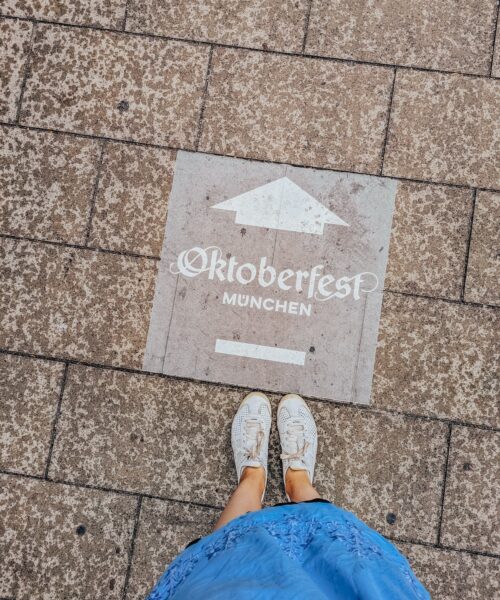
Whether you got turned around while trying to walk to the Wiesn or are too tipsy to remember how to get back to the trains, the city of Munich has got you covered!
From the central station (Hauptbahnhof) all the way to Wiesn, there are very obvious markers on the sidewalk that lead you to Oktoberfest. They say “Oktoberfest München” and have an arrow — it doesn’t get simpler than that!
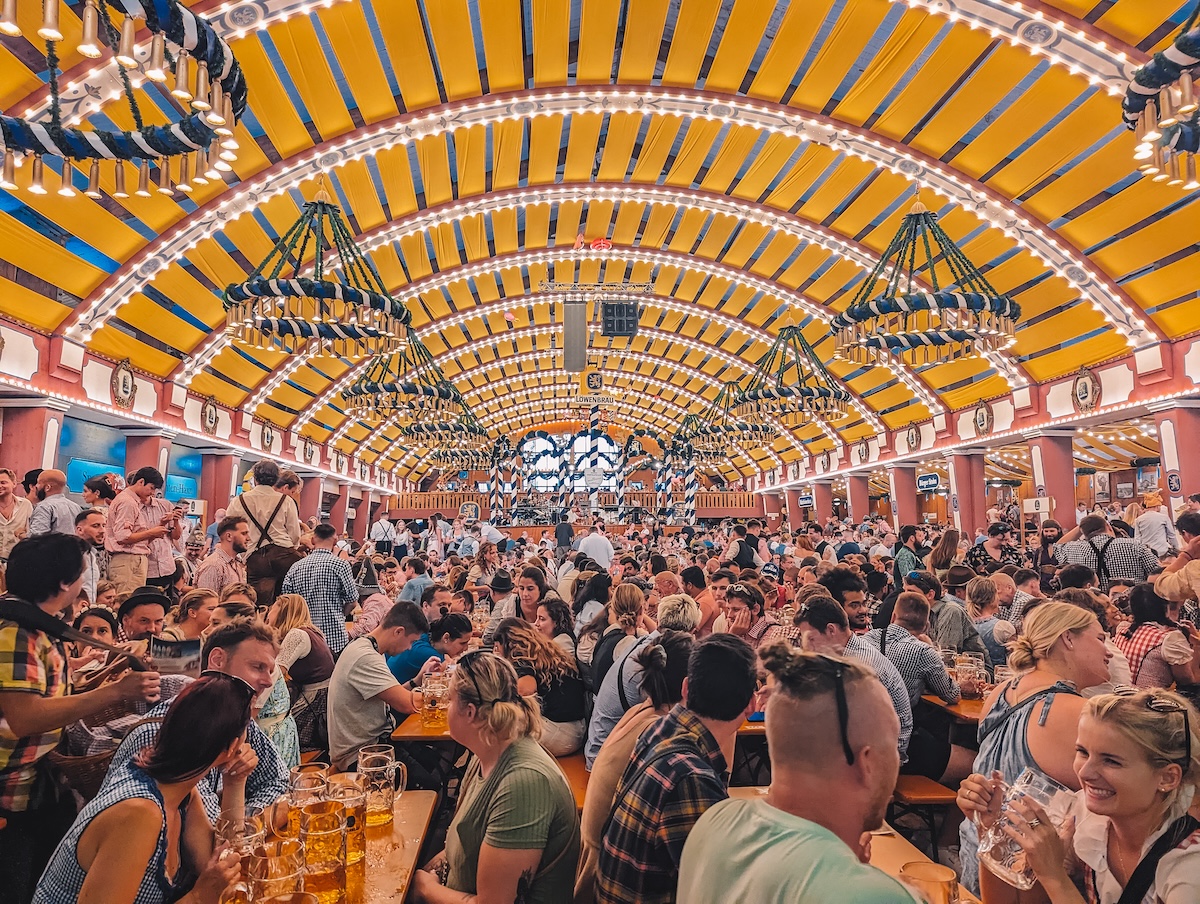
What Is Oktoberfest?
Oktoberfest is the world’s largest folk festival. Today it’s known for its epic beer tents, all-day drinking, live music, and giant pretzels, but did you know Oktoberfest has royal roots?
The event we now know as Oktoberfest began in October 1810. The marriage of Prince Regent Ludwig of Bavaria (later King Ludwig I) to Princess Therese of Saxe-Hildburghausen was celebrated over the course of five days. The festivities ended with a horse race in a meadow outside the city called “Theresens-Wiese,” meaning “Therese’s Meadow.” Sound familiar?
The epic marriage celebrations were so popular that the royal family brought them back again the next year and the year after that, until eventually the reins got passed to a private institution.
2025 marks the 190th running of Oktoberfest. It’s been canceled numerous times since its conception in 1810 due to world events such as the Napoleonic Wars, World Wars, the cholera epidemic, and the Covd-10 pandemic.
Why Does Oktoberfest Take Place in September?
That’s the million dollar question, isn’t it? The answer is simpler than you might think.
Oktoberfest runs from late September until the first weekend of October and has operated that way since 1872.
Why? Because Munich’s weather is often gray, drizzly, and cold in October and the festival goers wanted to drink their beer in the sunshine!
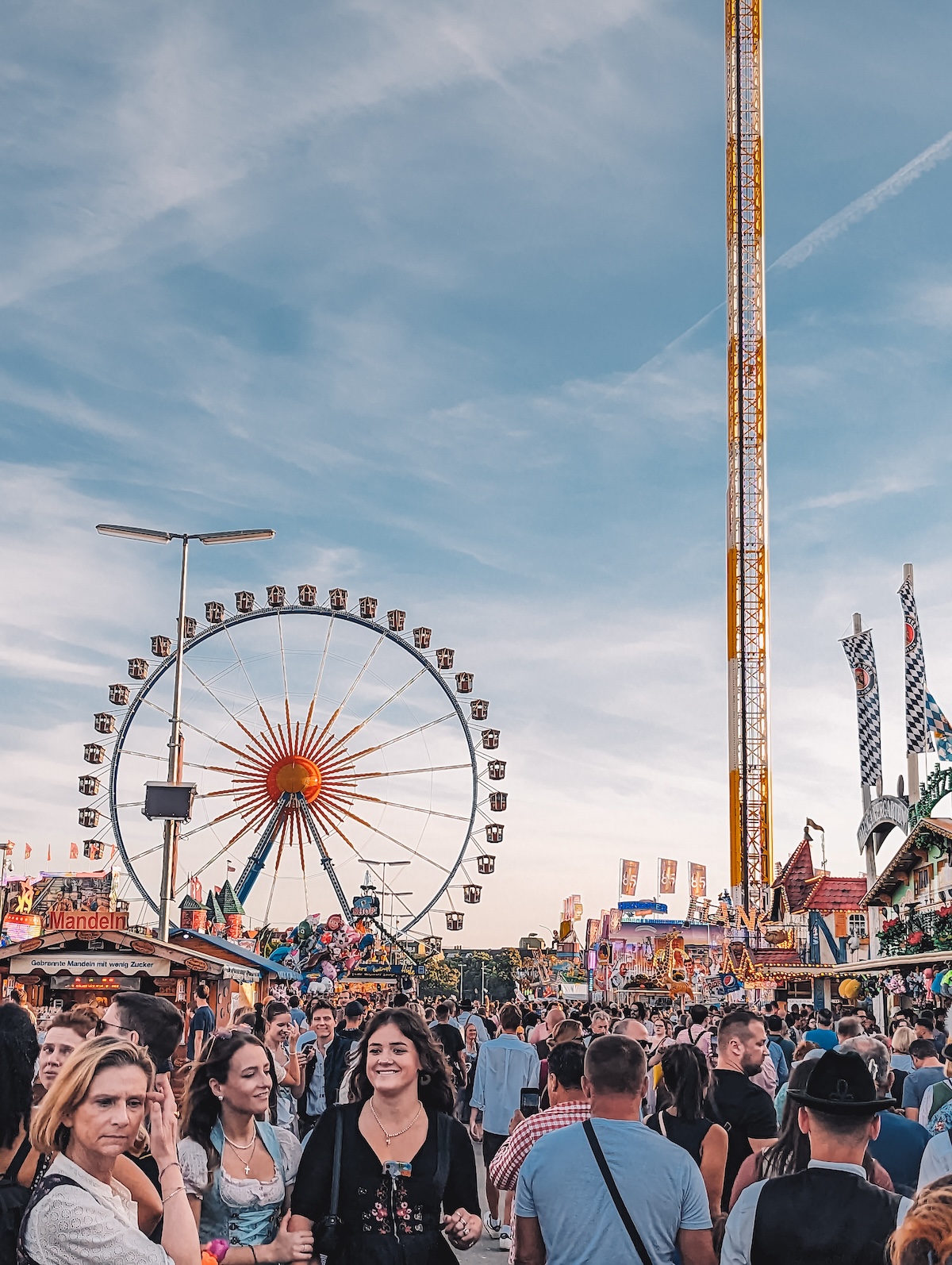
An Overview of What to Expect
I read numerous Oktoberfest guides in the lead-up to my first visit, and nothing prepared me for the magnitude of the festival.
For a few short weeks, the Theresienwiese (called “the Wiesn” by locals) is transformed into a small town of sorts. Temporary streets are constructed, with signs helpfully listing their names and pointing towards the main attractions.
Dozens of stalls line the streets. As you walk shoulder-to-shoulder beside the other Dirndl and Lederhosen-wearing festival goers, your eyes are drawn to the glittering beer steins, frosted heart-shaped gingerbread cookies, brightly painted clothespins, and kitschy magnets on offer, while your nose leads you to the juicy roast pork knuckle sandwiches, grilled bratwurst, and spiced candied almonds.
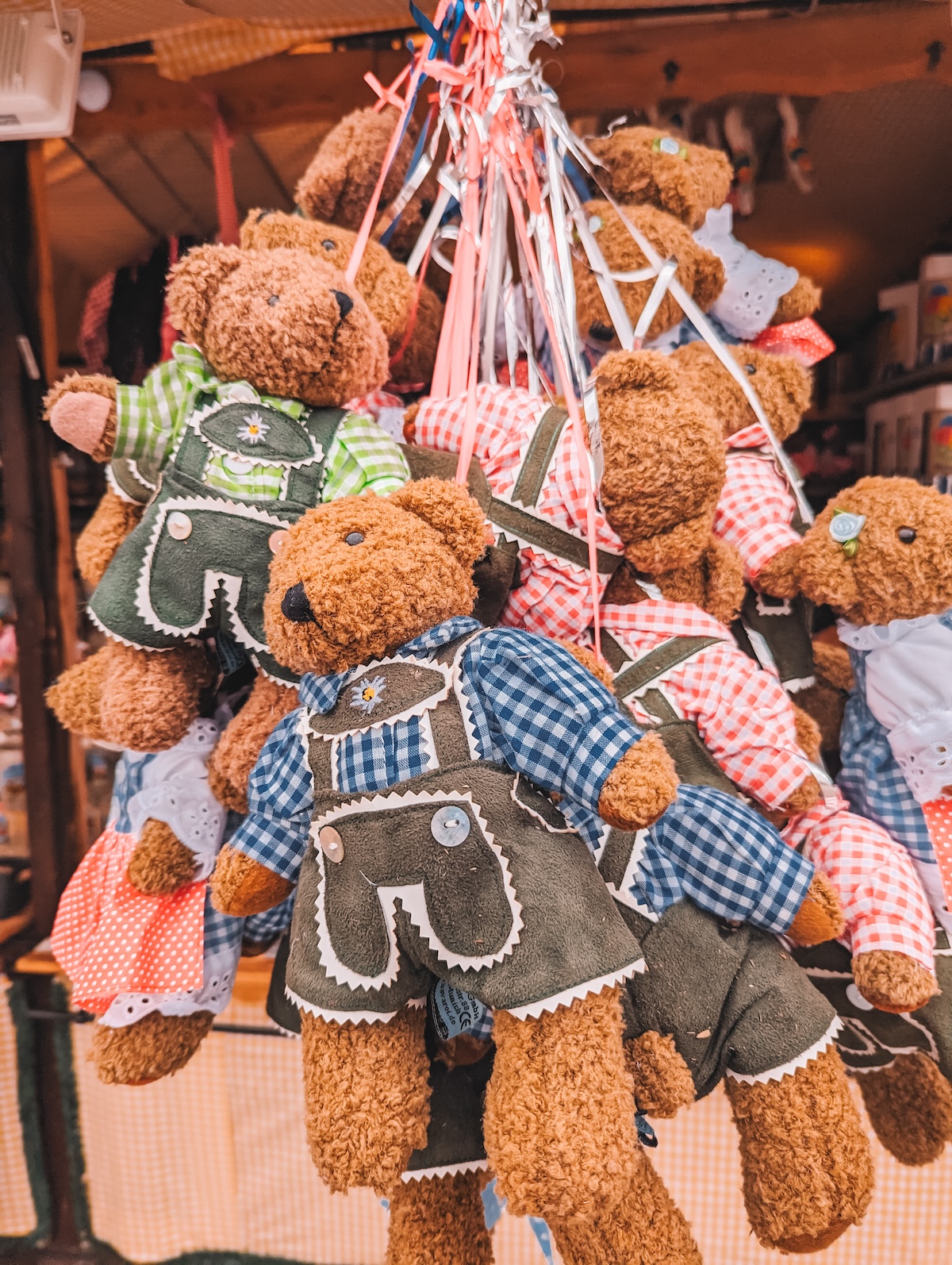
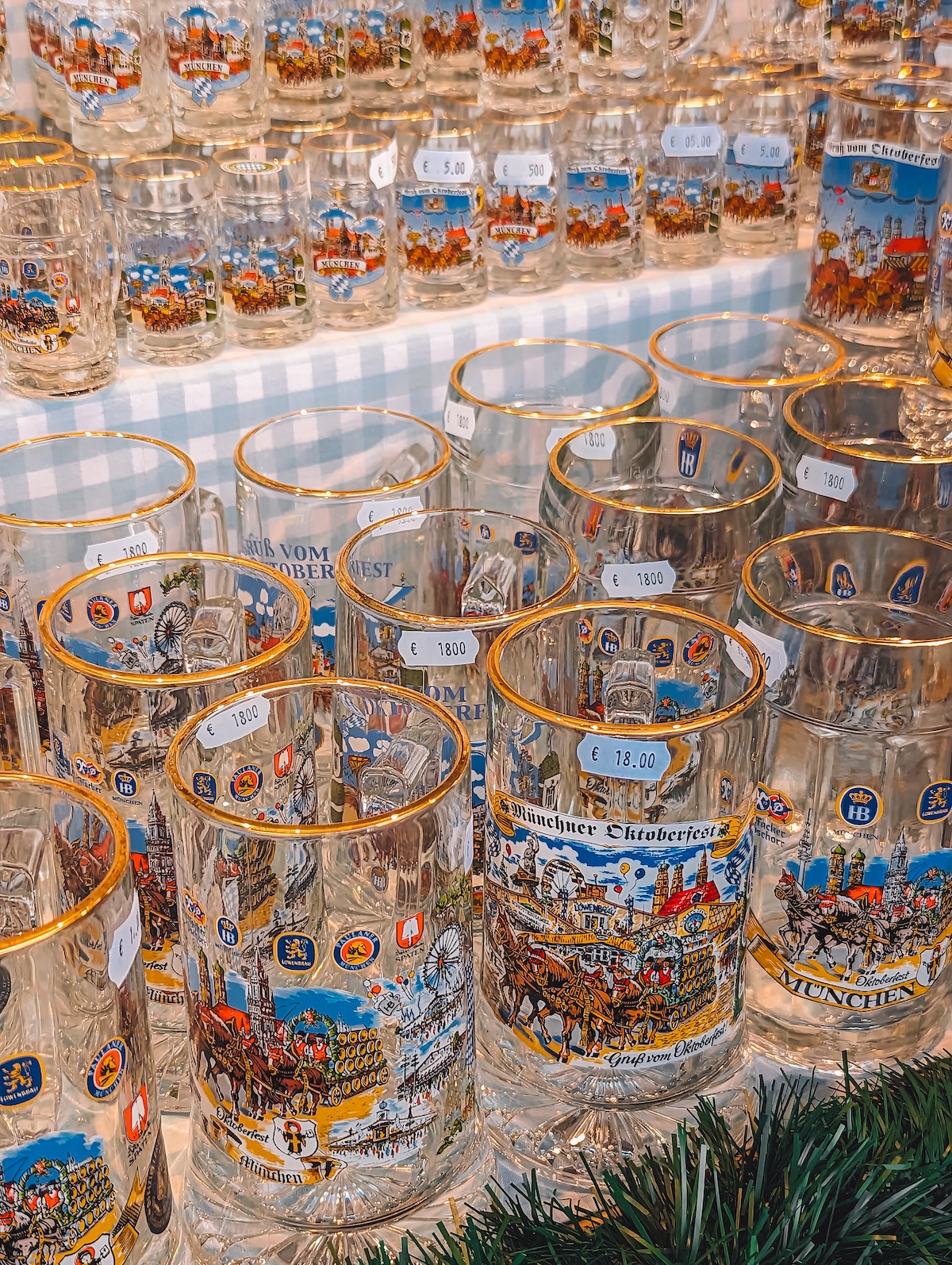
One section of the Wiesn is dominated entirely by the beer tents. These aren’t sloppily erected canvas tents like you see at your average traveling fun fair; these are multi-story drinking halls that can safely accommodate thousands of revelers.
There are 17 big beer tents and 21 smaller ones, and each sells beer from just one of Munich’s six historic breweries.
Once you step inside the tents, you’re transported into a different world entirely. Multi-colored bunting hangs from the ceiling and railings, long tables are packed with locals and foreigners exchanging stories about their Oktoberfest adventures, and waiters are stacking yet another empty stein onto towering piles to transport the lot back to the kitchens.
And is the brass band playing … Sweet Caroline? Yes, yes it is. The YMCA will likely be next, followed by a traditional Bavarian drinking song. Just go with it!
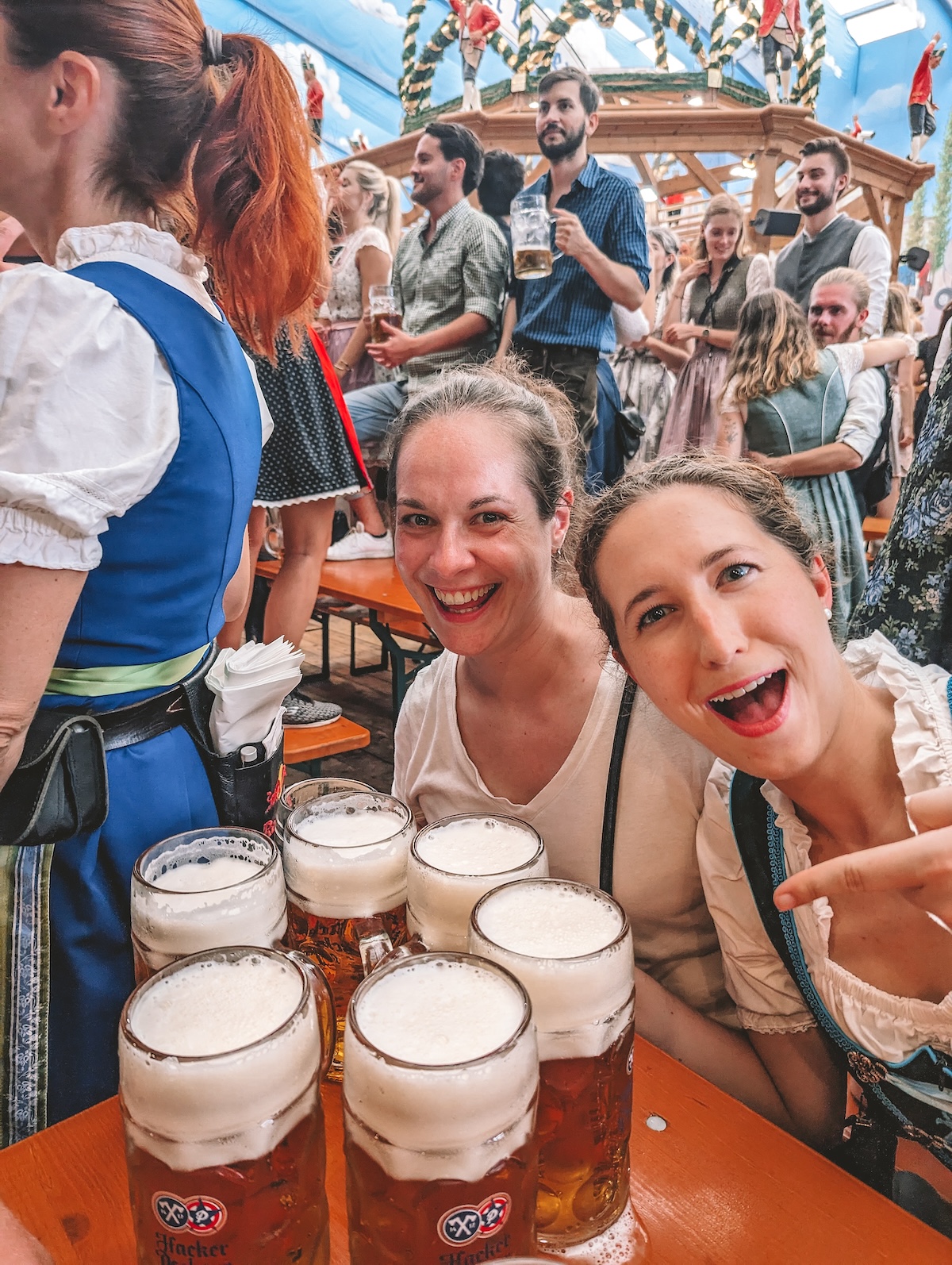
The beer tents at Oktoberfest are incredibly loud and overwhelming, but the atmosphere is infectious. Finding a table can be tricky if you’re with a big group, but if there’s just a couple of you then your best bet is to squeeze onto the end of whatever benches are available and get ready to make some new friends!
By the end of the day, you’ll know your tablemates’ life stories (or at least, as much as they can explain after having drank a Maß or two!). Be prepared to toast your steins every few minutes as a favorite song comes on or a new round of beer hits the table.
Once you’re feeling a little loose, hop up on the bench and dance alongside everyone else! Dancing on the tables is forbidden, but the benches are fair game.
After you’ve downed a liter (or more!) of beer and are ready for some fresh air, head back out to the Wiesn to take in the sights.
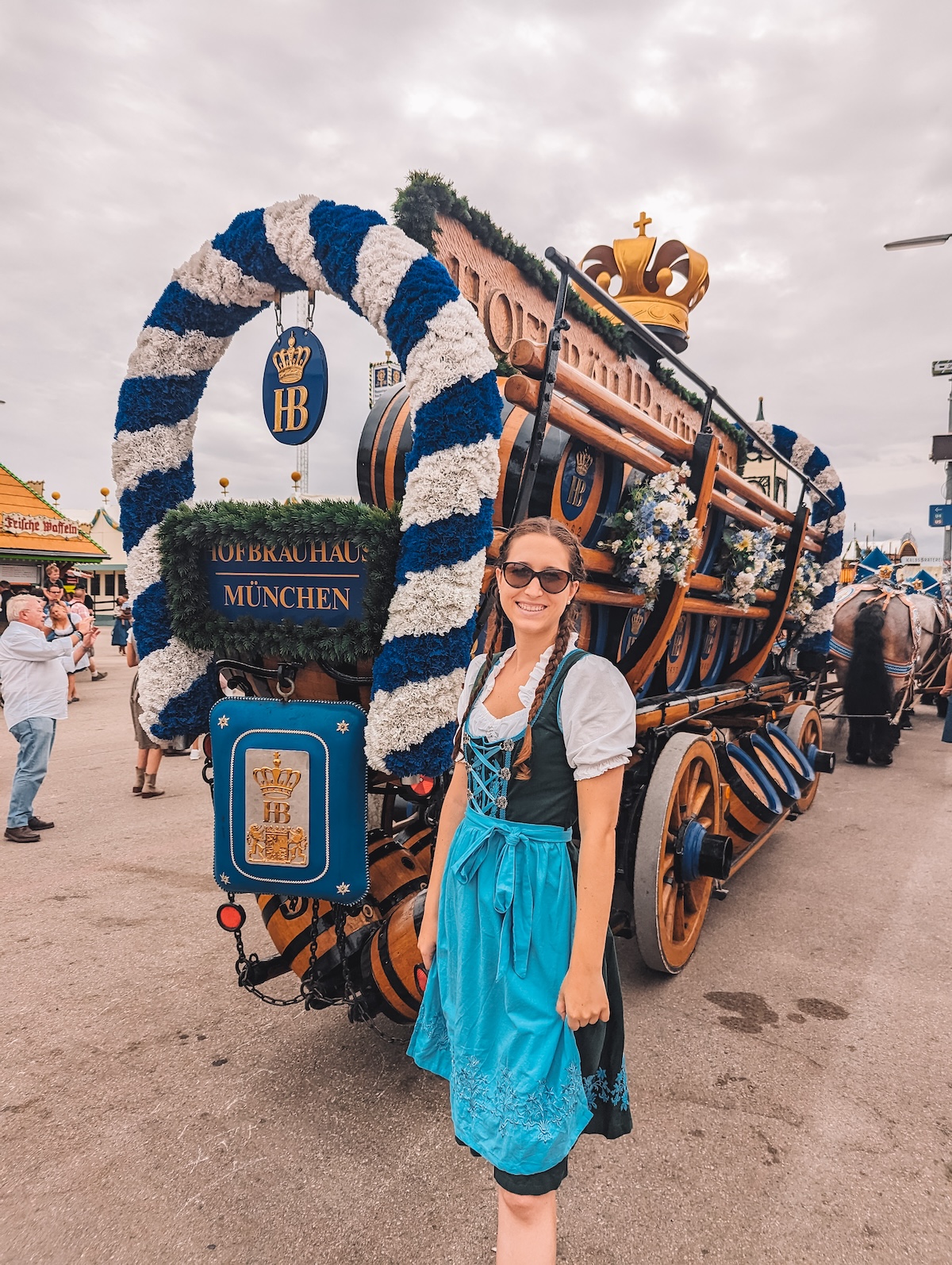
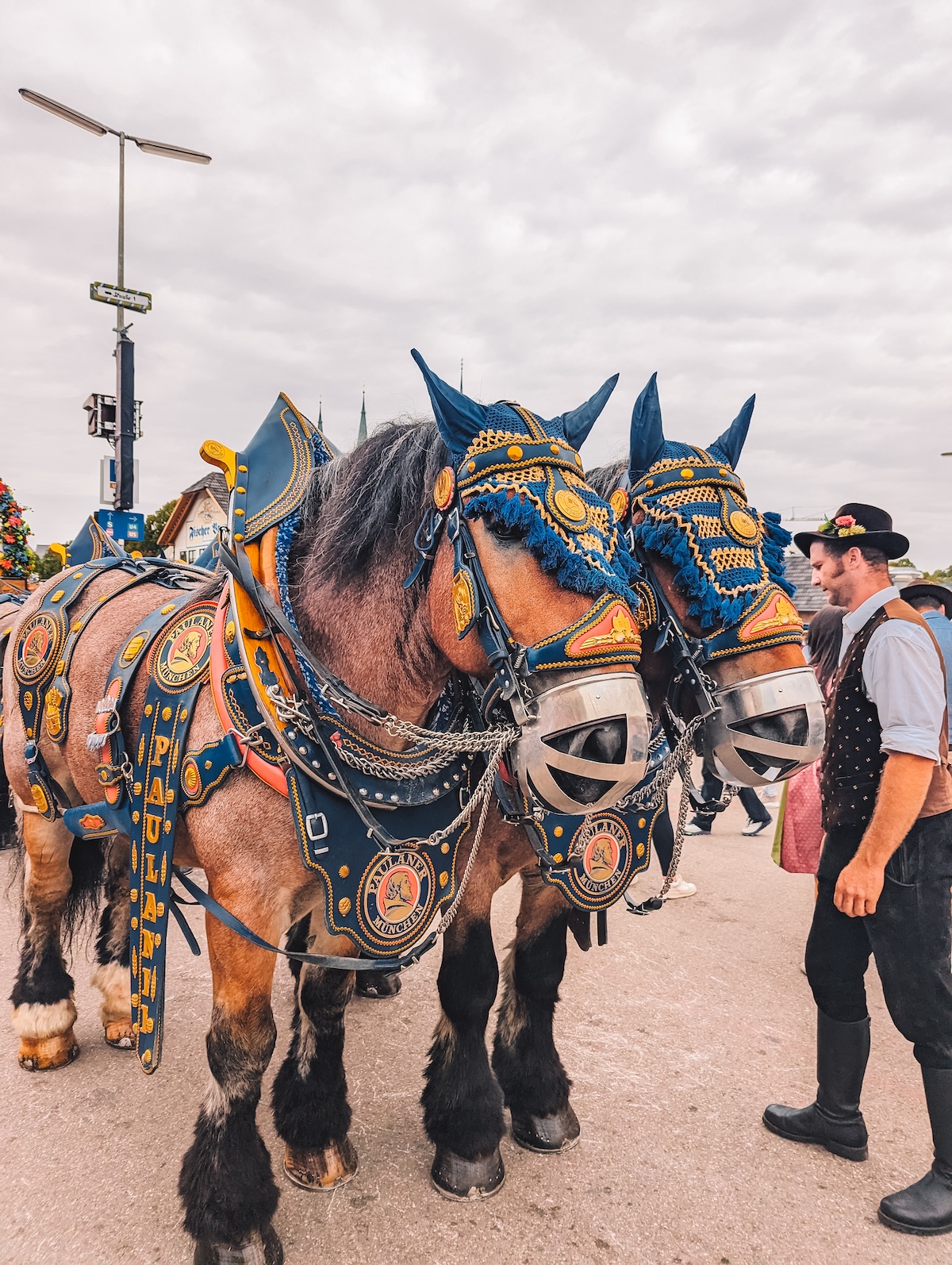
What to Do at Oktoberfest
There’s so much to see and do at Oktoberfest. Most people visit the Wiesn to drink their body weight in beer, but know that there’s lots more to enjoy too!
- Attend the opening day parade — Takes place the first Saturday of Oktoberfest following the tapping of the first barrel.
- Hang out in the beer tents — Duh! I’ve provided detailed information on the best beer tents later in this post.
- Visit the Oide Wiesen — This is the traditional section of Oktoberfest. You have to pay a small fee to enter, but the Old World rides, quieter beer tents, and fun snacks make this a great place to visit if the larger crowds of the Wiesn are starting to get to you.
- Walk through the beer tents — After you’ve drunk your fill, be sure to wander around a few of the tents. Each has its own unique decoration and they’re gorgeous! We only sat in two tents for long stretches of time, but we walked through almost all of them just to see how each was decorated!
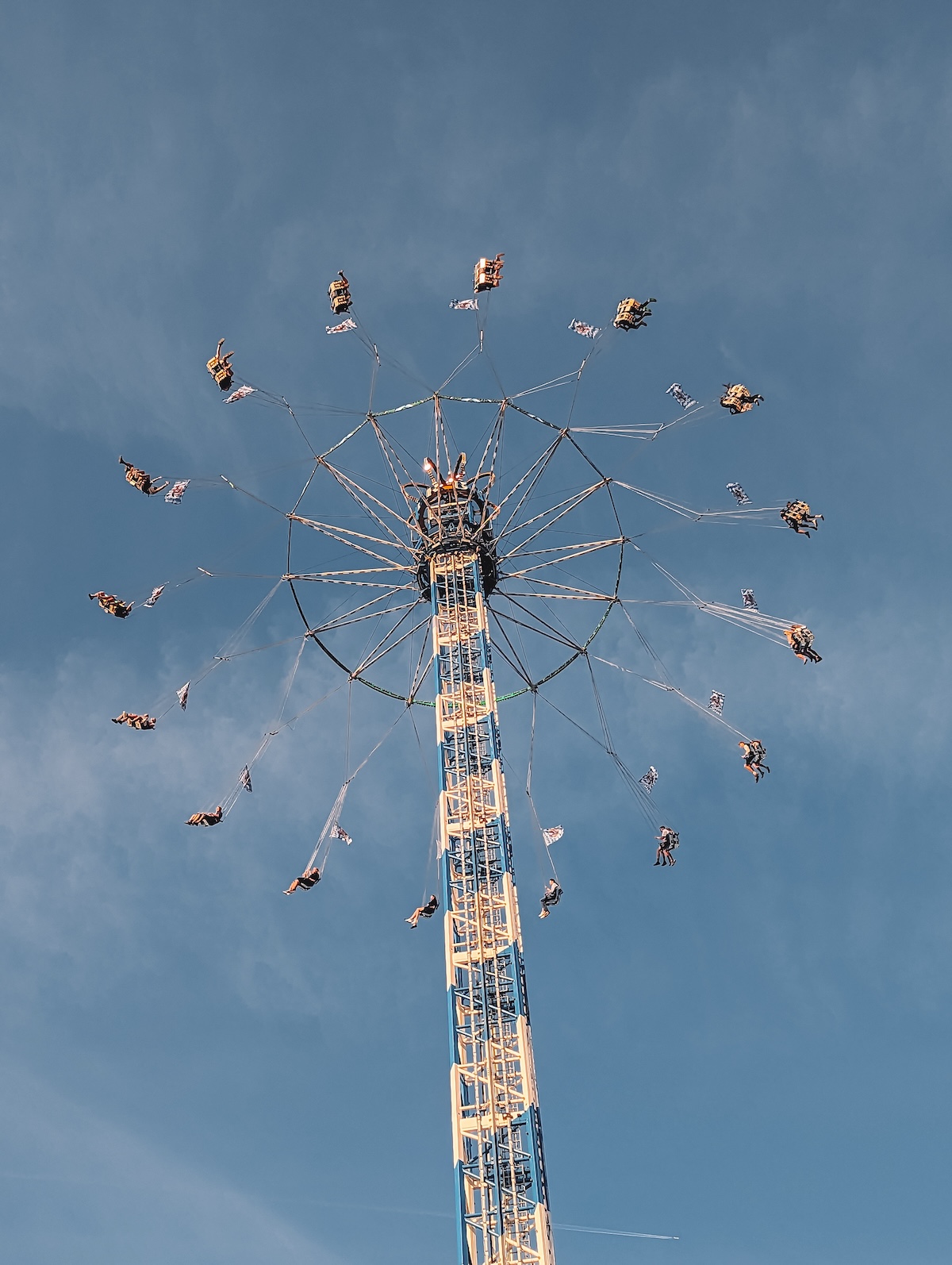
- Ride some rides — There’s a huge area that’s just fair rides and games. The Teufelsrad (Devil’s Wheel) is the oldest ride on the Wiesn, but walk around to see what others catch your eye. (I suggest riding any roller coasters before you begin imbibing …)
- Sample the food — There are lots of good eats both inside the tents (expensive option) or at the stalls outside (more budget-friendly option, but by no means cheap).
- See the brewery horses — Each of Munich’s six breweries has their own team of horses that pull the brewery carts. The horses are just as beautifully dressed as the people! The horses arrive in the morning and leave early afternoon. Sometimes they parade around the Wiesn but your best best is to look for them in front of their brewery’s tent.
- See the Bavaria statue — It’s an 18-meter-tall bronze statue of the female personification of Bavaria. She’s a beauty!
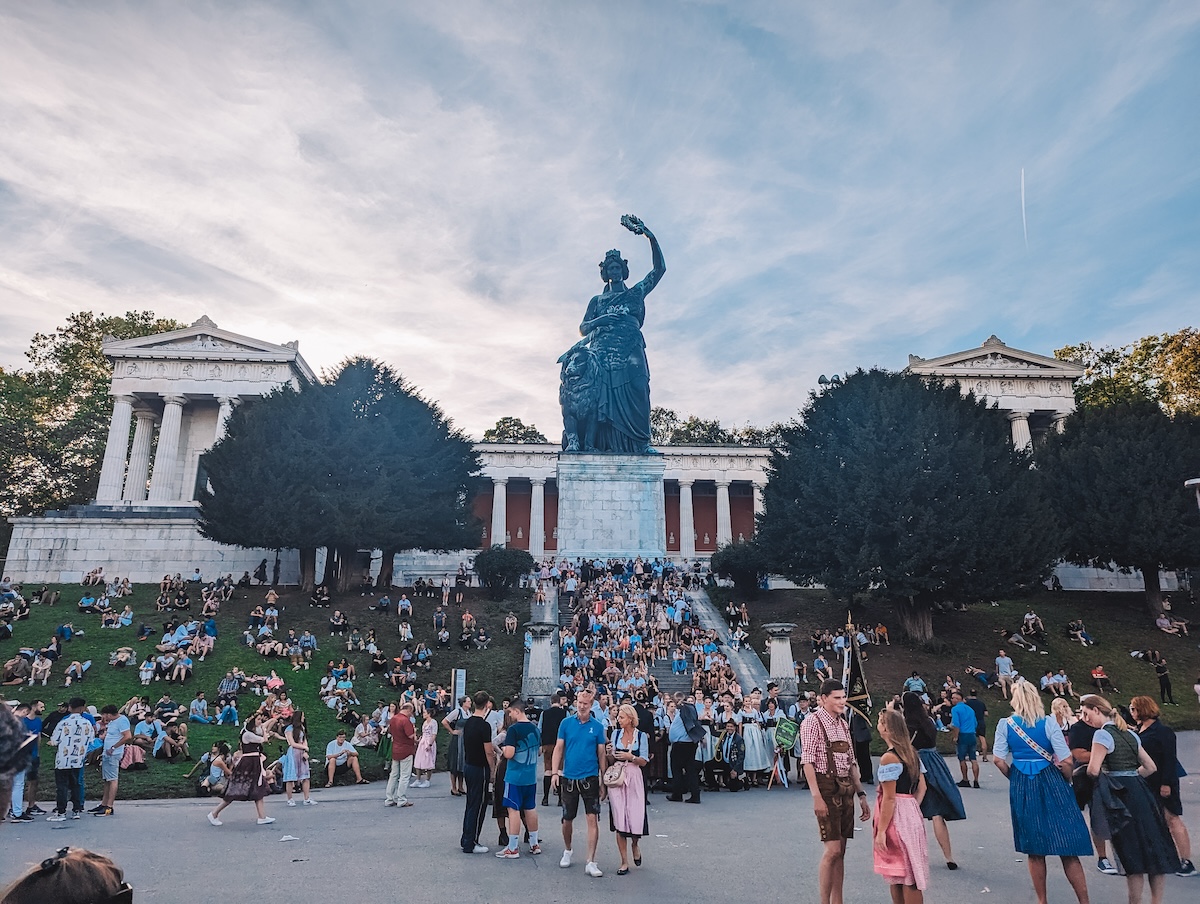
Getting to Know the Oktoberfest Tents
There are 17 large tents and 21 smaller ones at Oktoberfest. The six Munich breweries all have their own tents and are easy to find (they all have the brewery emblem very clearly displayed on or near their tent).
The Munich breweries are as follows: Augustiner, Hacker-Pschorr, Hofbräu, Löwenbräu, Paulaner, and Spaten. You will only find beer from these breweries at Oktoberfest, and each tent only sells one brewery’s beer (i.e. you won’t find a tent selling both Augustiner and Hofbräu).
I won’t go over every single tent at Oktoberfest because that deserves its own guide entirely. Below is a high level overview of the best of the big tents.
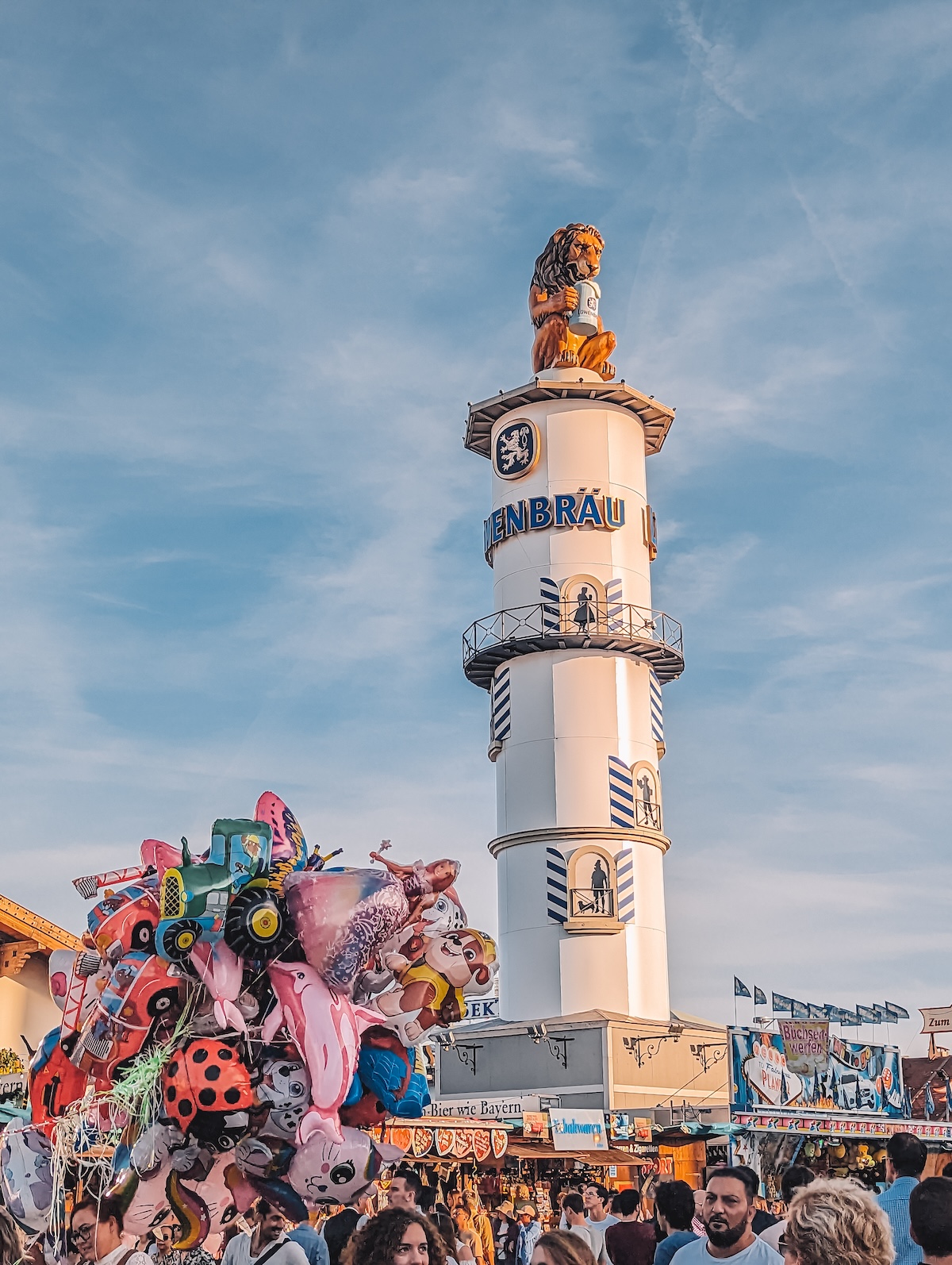
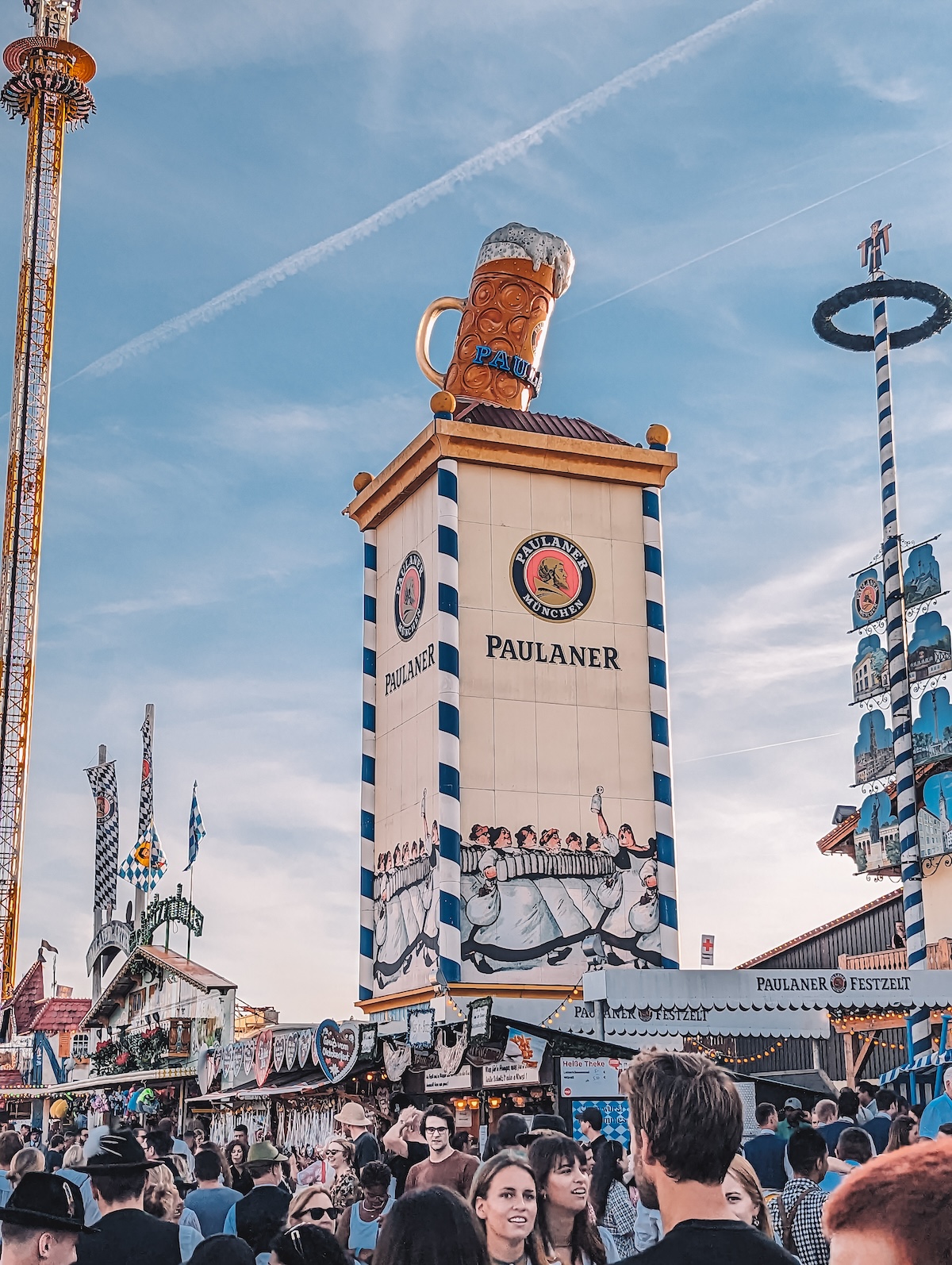
The Big 6 Breweries:
- Augustiner-Festhalle — This tent is more popular with families. Augustiner still taps its beer from actual wooden barrels!
- Hacker Festzelt — Arguably the prettiest test at Oktoberfest! The ceiling is painted to look like the sky, and the walls are decorated with famous Munich landmarks. Thus the tent was nicknamed “The Heaven of All Bavarians.”
- Hofbräu-Festzelt — The tent of Munich’s best-known brewery. The Hofbräu tent attracts more tourists than locals, but it’s beautifully decorated and is worth visiting if you like Hofbräu beer! The 12 giant hops wreaths hanging from the ceiling are the tent’s signature decor.
- Löwenbräu-Festzelt — A giant lion statue guards the tent and it roars every minute.
- Ochsenbraterei (Spaten Tent) — This is the place to eat whole roasted ox from a spit.
- Paulaner Festzelt — The easiest tent to spot thanks to the massive rotating beer mug on top of the tent. The interior is brightly lit and bedecked in yellow bunting.
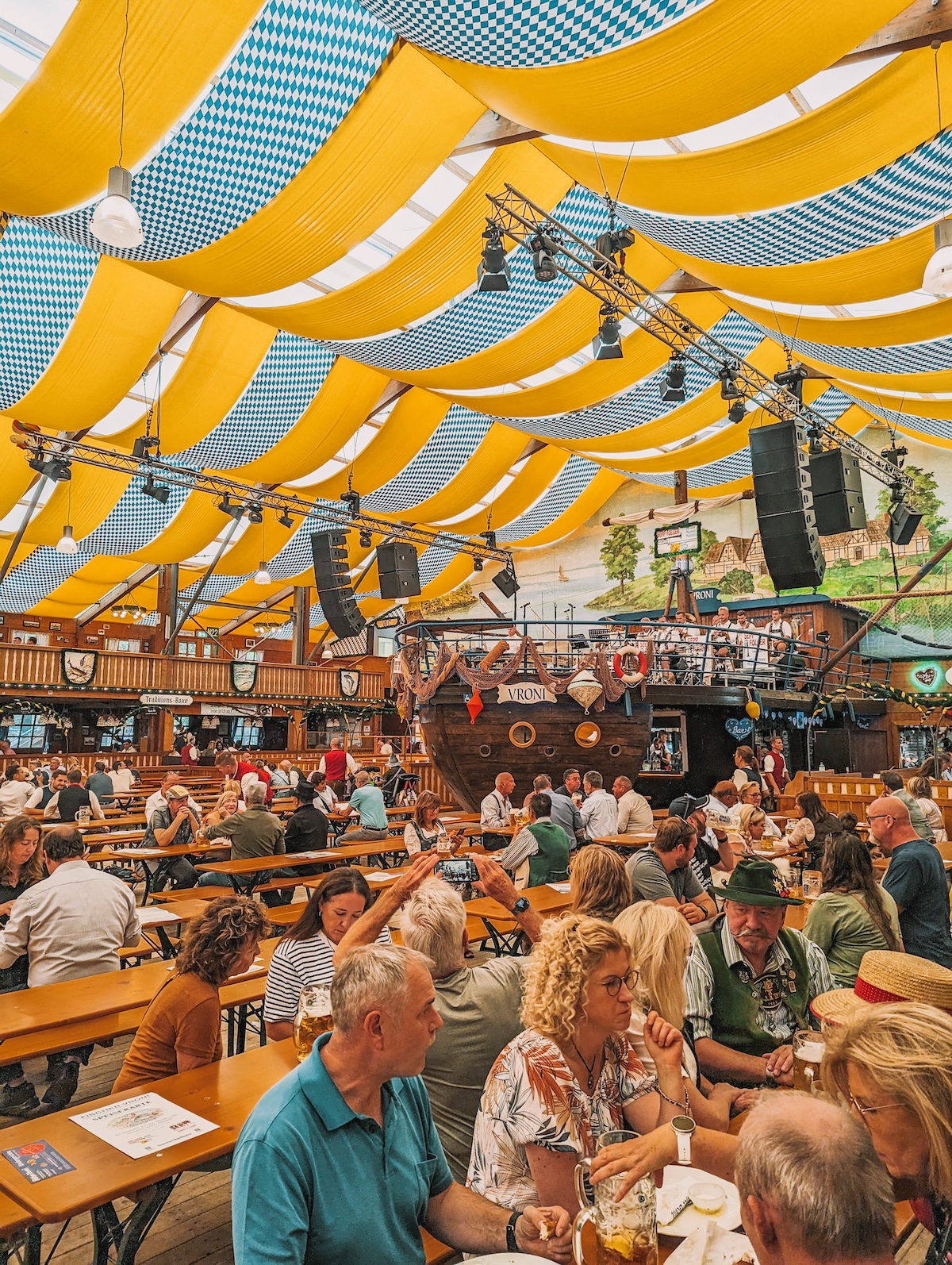
Other Great Tents:
- Armbrustschützen-Festzelt — A gorgeous tent decorated in Alpine style. The German crossbow championships are held here each year, and every Wednesday at noon there are performances by folk dancers and whip crackers. (We saw the whip cracker last year and they are amazing!)
- Fischer-Vroni Festzelt — This tent is known for its fish on a stick and is the only place you’re going to see fish sold in the tents. The Fischer-Vroni tent is a notable gathering place for the LGBT+ community; the second Monday of October is “Pink Monday” and this is where the community comes to celebrate.
- Kufflers Weinzelt — This is the wine tent of Oktoberfest. Instead of benches, you’ll find U-shaped seating. In addition to the drinks, the main thing that sets this tent apart from the rest is that it has live bands all day long, not German brass bands!
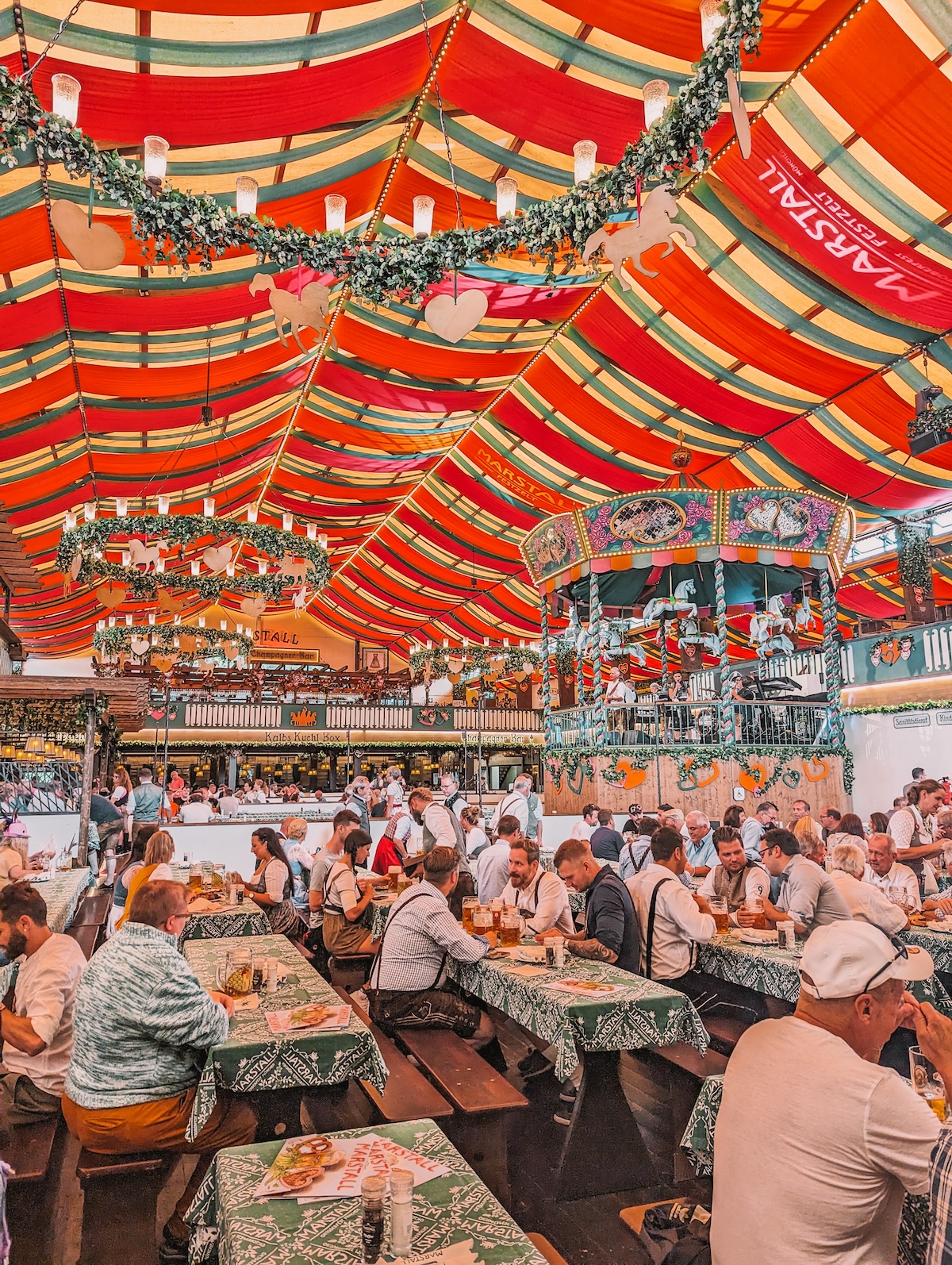
- Marstall Festzelt — Another family friendly tent. Dancing on the benches is not allowed until 4pm.
- Oide Wiesn — The “Traditional Festival” tent was introduced in 2010 to celebrate 200 years of Oktoberfest. You DO have to pay to enter this area (around 4 Euros), which has the upside of making the area a bit quieter and more relaxed. The tent plays traditional brass band music and folk dancers perform throughout the day.
- Schottenhamel Festhalle — This is the oldest tent at Oktoberfest and is where the first beer of the festival is tapped by the mayor of Munich. The Schottenhamel family has been at Oktoberfest for more than 150 years!
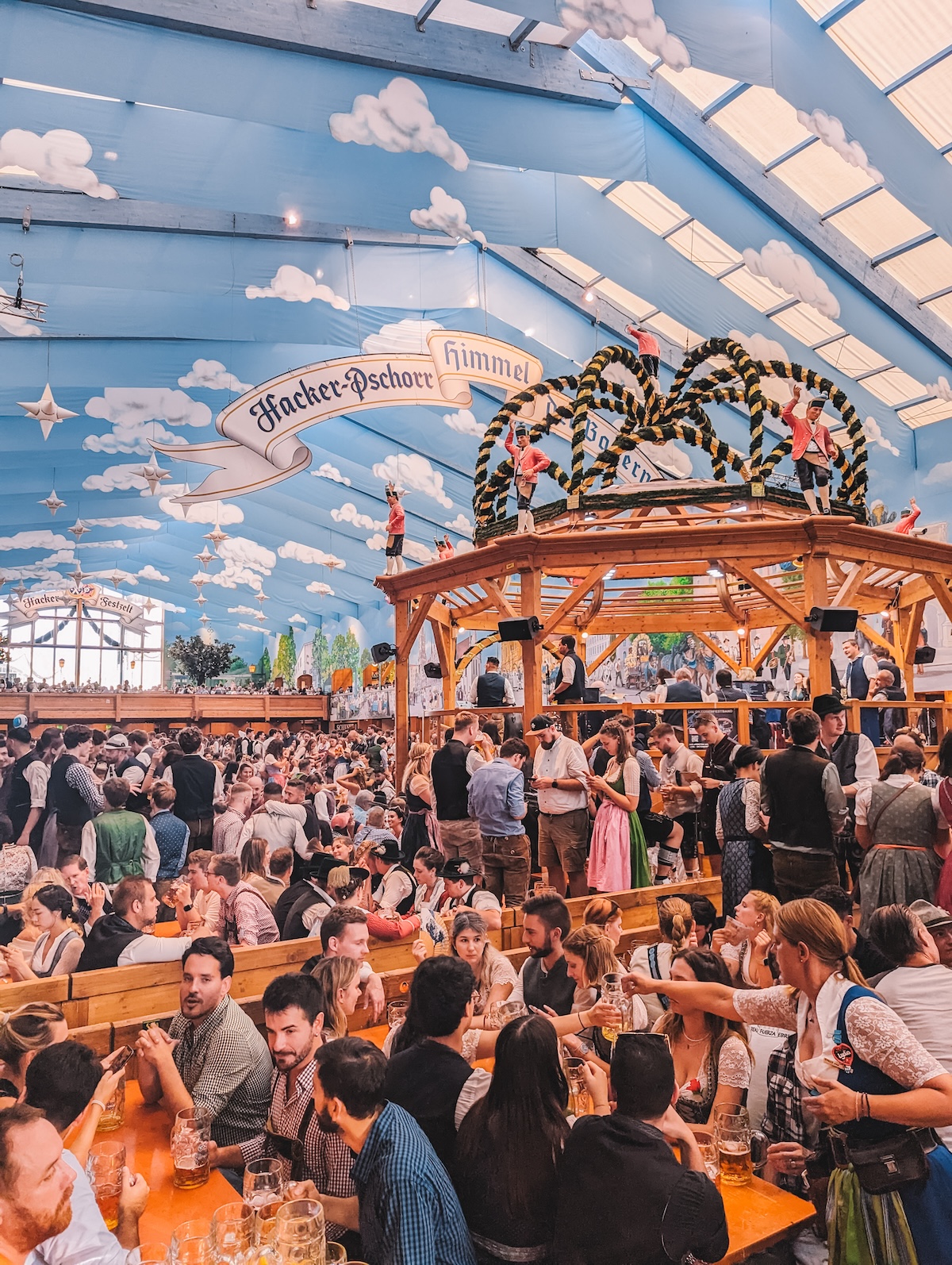
Which Tents Are the Best?
Generally speaking, I preferred the atmosphere inside the 17 bigger tents during the day. The music was better, the crowds were lively, and it was easy to get drinks. The smaller tents and venues are fun, but they don’t have nearly the same infectious atmosphere in my opinion.
Of the big 17, there’s no single tent that’s better than the others — it really just depends on the ambience you prefer and what beer you like best!
My two favorites from last year were:
- Hacker Festzelt – The “Heaven of All Bavarians,” painted to look like a blue sky. The tent fit tons of people yet the service was impeccable, plus there was a good mix of foreigners and locals so it was easy to talk to everyone.
- Armbrustschützen-Festzelt — We wandered into this tent on a whim and wound up staying for a few hours. There’s good music, and the whip cracking took us totally by surprise!
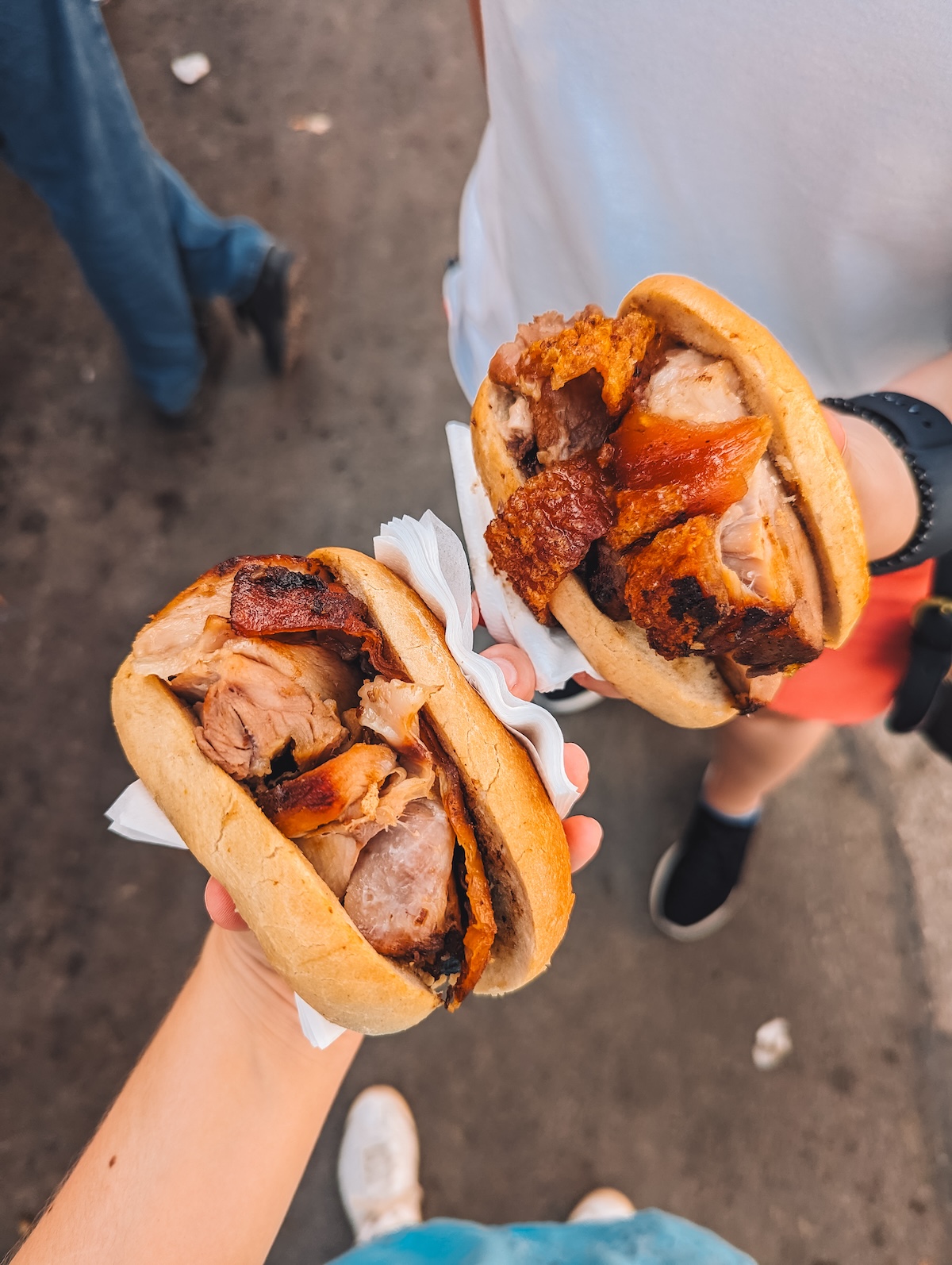
Oktoberfest Foods & Drinks
The foods and drinks at Oktoberfest are so tasty, albeit somewhat pricey since constructing the beer tents each year takes over two months.
Here are just some of the foods and drinks you need to try at Oktoberfest:
- Beer — The star attraction! The beer is brewed exclusively for Oktoberfest by Munich’s Big Six breweries. It’s a true heritage product that supports the local breweries. The beer at Oktoberfest contains around 6% ABV.
- Other drink options — Wine (from the wine tent), Radler (a shandy made with beer and lemonade), Apfelschorle (sparkling water and apple juice – my favorite drink!), and Spezi (cola mixed with orange soda – a local favorite!). Most tents also have non-alcoholic beer as well as mineral water.
- Pretzels (Brezeln) — The ones sold in the tents are bigger than your head and are actually so good! Bavaria is where pretzels originated, and they’re always perfectly fluffy and not too dry.
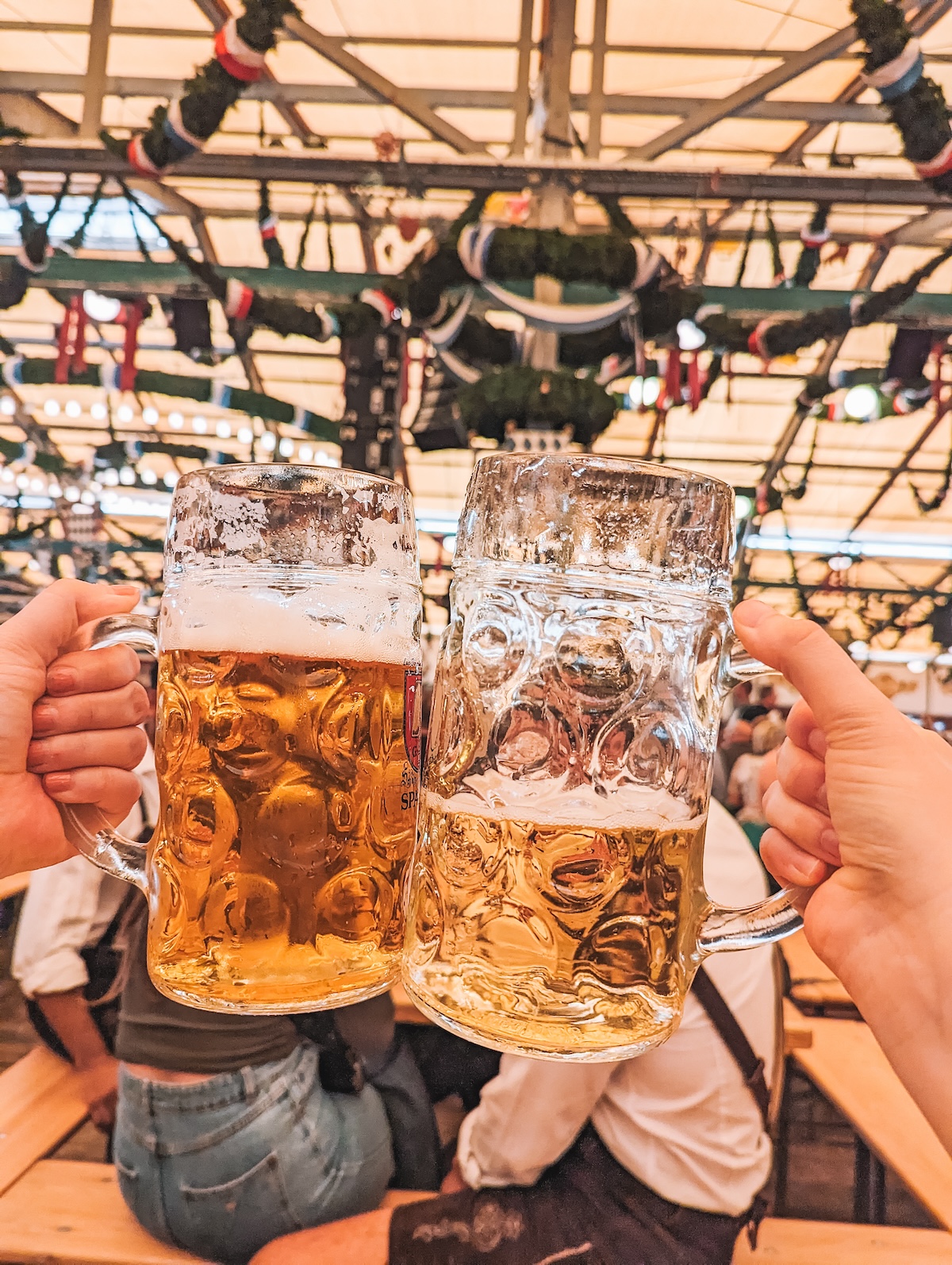
- Roast chicken (Hendle) — You can buy whole or half a roast chicken depending on where you order from.
- Pork knuckle (Schweinshaxe) — The most succulent cut of pork you’ll ever eat! The ultra crispy skin coating the pork is to die for. You’d be hard pressed to eat an entire pork knuckle on your own, so order some meat shaved off the bone and made into a sandwich or split a whole one with a friend.
- Bratwurst — Grilled sausages are easy to find all over the Wiesn and are one of the more affordable food items. Get yours topped with sauerkraut (pickled cabbage) for the full Oktoberfest experience.
- Roast ox (Ochsenbraten) — Super tender roast beef, typically sold inside the tents and not at the outdoor stalls. Head to the Ochsenbraterei tent to sample the best of the best.
Claire’s Tip: Many of the German foods sold at Oktoberfest are similar to what you can eat at a German Christmas market! Click both of those links for more details and photos on popular German foods you’ll likely spot on the Wiesn, too.
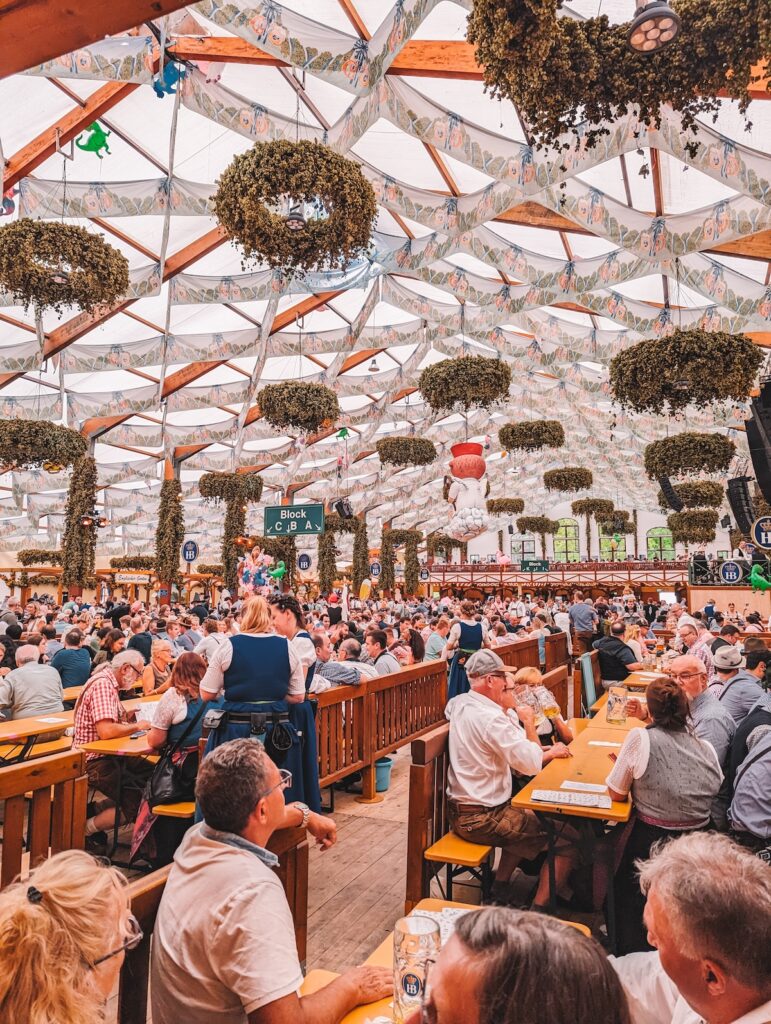
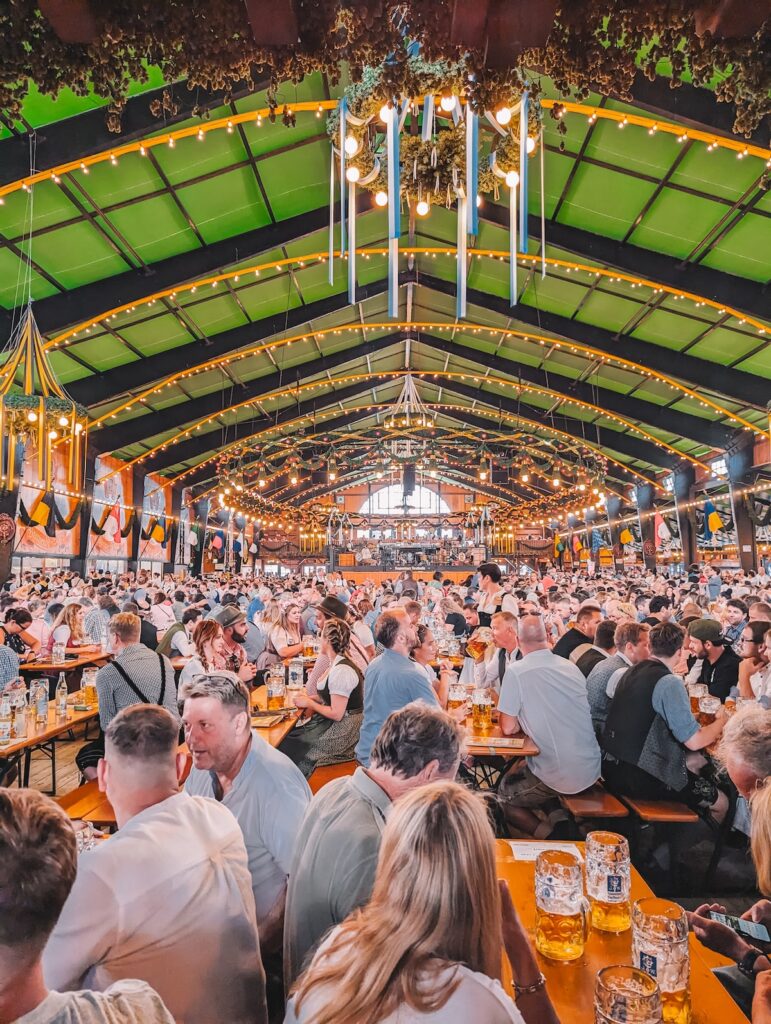
Where to Stay in Munich for Oktoberfest
If your budget allows, I highly suggest staying within walking distance of the Theresienwiese. That way you won’t have to mess with public transportation or taxis. (Remember that you will NOT be able to drive to and from the Wiesn since you’ll be drinking alcohol!)
However, if you end up booking a hotel further away to save money, select one with easy access to the U3, U4, U5 or U6 subway — those will all take you straight to the Wiesn.
Top rated Munich hotels that would be a good place to base your Oktoberfest adventures include:
- Lizz Hotel Munich — 10 minute walk
- Schwan Locke — 5 minute walk
- Relexa Hotel München — 10 minute walk
- mk | Hotel München City — 15 minute walk
- Bold Hotel München Zentrum — 5 minute walk
Last year, we booked our hotel fairly last minute and wound up at a place nearly 30 minutes from the Wiesn. It wasn’t ideal but we still had a great time! Moral of the story: Stay where there’s room and know that you might have to take a taxi to get back if you drink too much later!
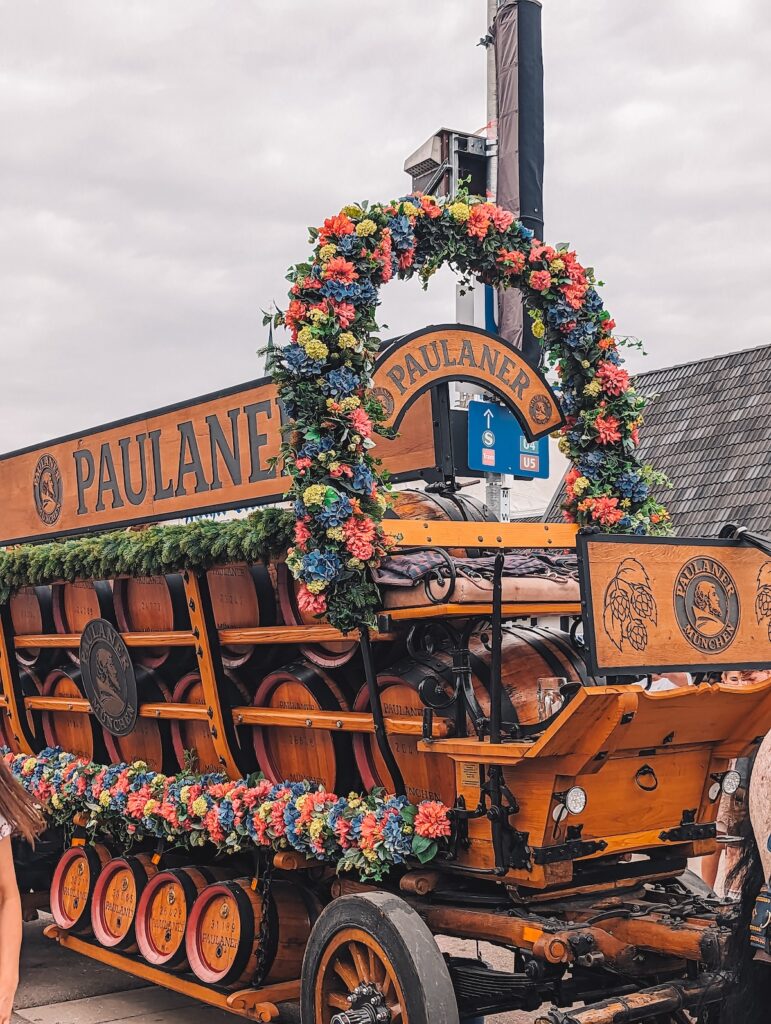
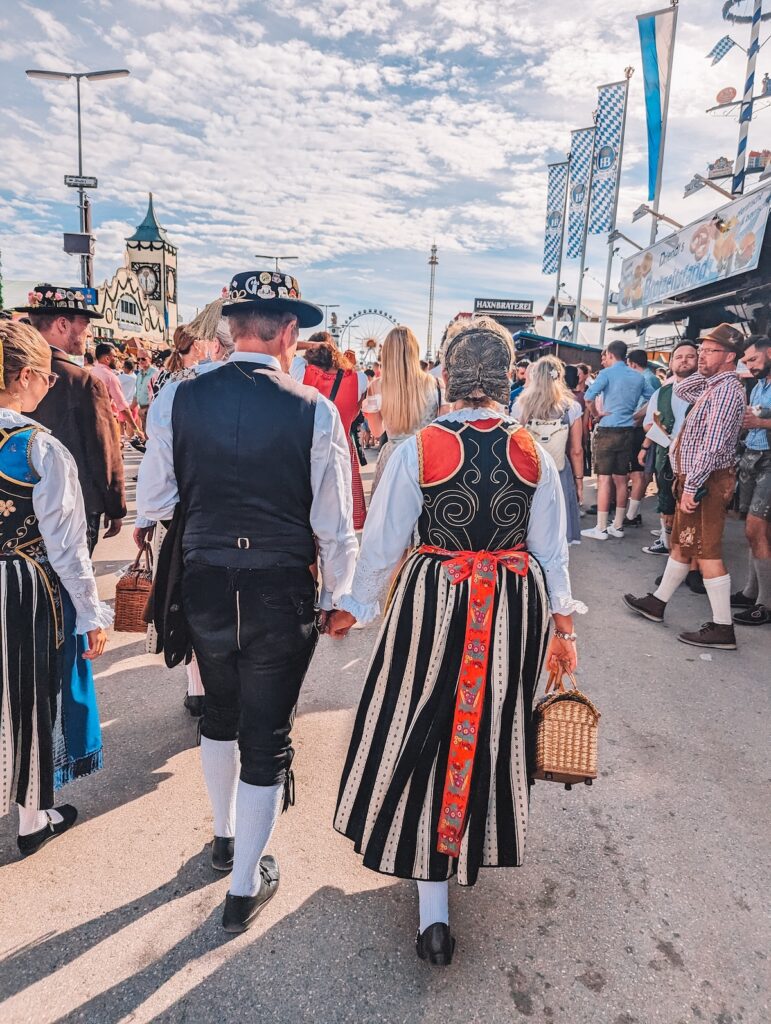
Your Oktoberfest FAQs – Answered!
We spent two afternoons on the Wiesn and thought that was the perfect amount of time. I liked having more than one day on the Wiesn because it allowed us to hang out and have fun in a tent one day and then explore the Oktoberfest grounds at our leisure the next.
Do NOT plan to spend a full week at Oktoberfest. A full week in Munich itself would be great, but you cannot possibly spend a full week in the beer tents.
Cash is king at Oktoberfest, and in fact many of the food stalls and beer tents don’t accept credit cards. Bring smaller bills (20 Euros or less) to make the waitstaff’s lives easier, and remember to bring coins so you can add tips!
Exact change is preferred but otherwise you hand over your bills and tell the waiter how much money you want back — they keep wallets on them so paying doesn’t take long.
Yes! The waitstaff positions are highly coveted and many people take time off of work specifically to work the tents for those tips! Per liter of beer, I recommend adding a 1 to 3 Euro tip.
No, the Wiesn is free to enter and so are the tents (unless you paid in advance to reserve a table or you’re paying to attend as part of a tour.)
Just walk right in! There’s usually security at the entrance to check bags (I didn’t get checked every time, but often enough). If a tent is full, security will turn you away.
If you’re a small group (2 to 3 people), you’ll likely have luck squeezing onto the end of a table. If you’re a larger group without a reservation, show up early in the day to secure a spot!
So long as a tent has the capacity for more people, you’ll be let in and will have to fend for yourself to find a spot to sit.
Inside the tents, you can only purchase a Maß (liter) of beer. A Maß costs between 14.50 to 15.80 Euros, and you’ll need to add a tip on top of that.
It depends on how much beer you think you’ll drink, whether you’ll be eating inside the tents (more expensive) or outside from the stalls (less expensive than the tents, but by no means cheap). Also take into account whether you plan on buying souvenirs or riding the fair rides!
I don’t drink alcohol, ate exclusively from the stalls outdoors, didn’t purchase souvenirs or ride any rides, and I spent around 50 Euros both days I was at the Wiesn.
I consider that to be a “budget” Oktoberfest visit, so for most people I’d plan on spending at least 80 Euros per day just to be safe.
YES! I imbibe maybe once per year, hate beer, and LOVED every minute I spent at the Wiesn. The beer tents are jam-packed and very loud on the weekends, so I found it impossible to order a non-alcoholic drink then (I simply popped outside to take a sip from my water bottle when needed and then returned to my table; my liter of beer was passed to someone at my table).
During weekday afternoons, the tents were not nearly as busy and I could comfortably order a non-alcoholic beverage. The tents have such a fun, inviting atmosphere and no one cares what you’re drinking so long as you’re dancing on the benches, singing, and having fun!
If you’re visiting with a big group, then yes. There’s no central website for reserving tables inside the tents; you have to visit each tent’s website and book through their own links. Note that reserving a table comes with a minimum spend requirement, so only reserve a table if you have enough people to fill it!
And if all the tables have filled up already (they go fast!), still show up with your group and be prepared to sit at different tables if needed.
If you’re traveling with one or two other people, don’t bother with a reservation because you’d have to pay for the entire table.
Dancing on the benches is allowed and everyone does it! Dancing on the tables is forbidden, however.
Have to? No. Should you? I think so!
Walking around the Wiesn, you’ll see lots of Dirndl (traditional Bavarian dresses for women) and Lederhosen (traditional leather pants for men). You can spot the locals by the quality and fit of their folk dress, as well as their accessories.
Many foreigners wear essentially Halloween costume-quality folk dress, and that’s fine too! I think wearing a Dirndl or Lederhosen is a fun way to experience Oktoberfest and I highly encourage wearing one.
I live in Berlin and found my Dirndl at a local Humana (a second-hand store).
In Munich, there are many stores that specialize in Tracht (Bavarian folk dress). During Oktoberfest season, even chain retail stores like Karstadt sell Dirndls and Lederhosen.
If you don’t have the time or desire to buy a traditional outfit for Oktoberfest, you can rent them for a short period of time (look at Bavarian Outfitters or email local stores to see if they do rentals — chances are, they do!). My suggestion: book your rentals NOW to ensure you have a beautiful outfit for Oktoberfest!
The key is to pack light. Only small bags are allowed onto the Wiesn (20 cm x 15 cm x 10 cm, which is 3L).
I brought this Uniqlo shoulder bag last year and it was great. The bag costs 15 bucks and holds WAY more than you’d think. I fit a 500ml water bottle, a small wallet, my phone, sunglasses, and some Advil without issue.
Definitely bring a water bottle with you too (must be plastic, glass is not allowed). Note that you can’t drink your own beverages in the tents; I kept mine in my bag and sipped when I was taking fresh air breaks.
Yes! There are bathrooms scattered around the grounds and each tent has one (including what looks like a giant, shallow sink but is actually … a vomitorium).
Bring a Euro or two into the toilets with you so you can tip the workers. The bathrooms are free of charge, but it’s polite to tip the workers — would YOU want to clean up the bathrooms after thousands of people used them post-drinking? Exactly. Leave a tip!
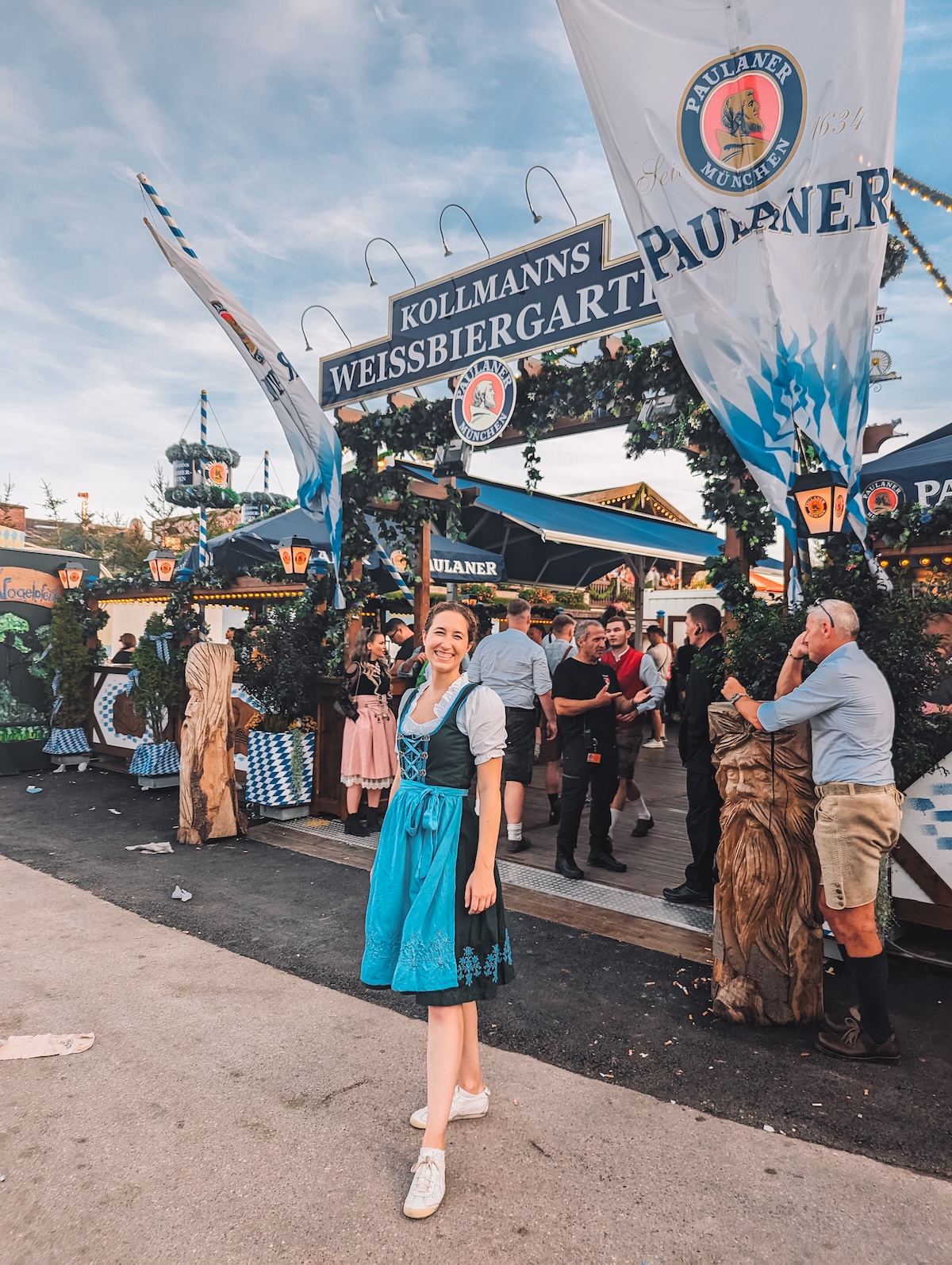
Final Thoughts
For as long as this guide is, it still doesn’t cover all there is to know about visiting Oktoberfest for the first time. Leave me additional questions below, and if you visit Oktoberfest with the help of this guide please let me know!
Don’t forget to follow me on Instagram to keep up with my daily adventures in Berlin and beyond!

Comments & Reviews
Thanks Claire,your information has been invaluable & very helpful😊😎🍻🇦🇺
I’m so glad you found this guide helpful, Jamie! I know it was a long one. Enjoy your time on the Wiesn!